| 13. A perspective for delinquent youngsters |
| The Indian context |
| |
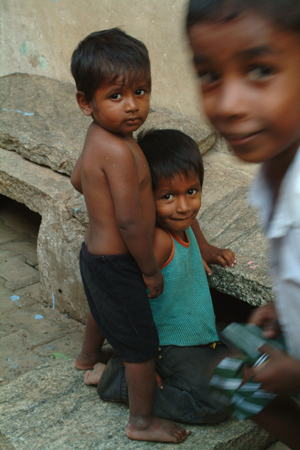 |
|
In order to offer perspective to children that are at conflict with the law I want to share experiences from India in this chapter. The concrete suggestion is to recognize resilience and to offer perspectives.
|
| |
 |
| |
| A child’s future can never be a drop in the ocean |
| Through a sponsored project of a school in India I met Fr. Antony Sebastion. He is the first catholic judge in India. Besides he is director of ECHO (Empowerment of Children and Human Rights Organisation), an organisation which takes the human rights of children very seriously. His work is in size and impact perhaps literally indescribable. But the interfaces with powerful concepts which are familiar to us, are evident. I visited his project in Bangalore, a crowded city where ideals are realized. |
| |
M Gandi: “I believe in the absolute unity of humanity. We may live in a thousand rooms, but they are all connected with each other”
|
| |
| |
| The child’s rights |
| To give every child a chance among others the Rights of the Child were drawn up. The treaty concerning The Child’s Rights is based on the Universal Declaration of Human Rights. It was adopted by the General Assembly of the United Nations on 20 November 1989 and it has been in force from 2 September 1990 after ratification by 20 member states. It is usually called the Declaration of Children’s Rights. The Netherlands ratified the treaty in 1995 and India accepted the treaty in 1992. The Child’s rights consist of 54 articles. A number of (simplified) children’s rights which are endorsed globally: |
| • Every child has a right to live. |
| • Every child is entitled to a name and a nationality |
| • Every child has a right to form its opinion and to express itself freely. |
| • Every child has the right to the highest degree of health and medical care |
| • Every child is entitled to make use of social security |
| • Every child is entitled to a standard of living which is sufficient for its physical, mental, intellectual, moral and social development. |
| • Every child has a right to education. |
| • Every child has a right to protection against economic exploitation and work which is dangerous or which will hinder its education or which will be harmful for its health and its physical, mental, moral and social development. |
| |
| |
| The millennium targets |
| In 2000 the heads of government of 189 countries agreed to tackle the most important global problems before 2015. Eight concrete aims were laid down: the millennium targets. |
| Here they are in short: |
| 1. To half poverty and take care that fewer people will suffer from starvation. |
| 2. Every child has to go to school. |
| 3. Men and women are equal. |
| 4. Less infant mortality. |
| 5. Improvement of the health of mothers. |
| 6. Fighting HIV/aids, malaria and other deadly diseases. |
| 7. Protection of the environment, clean drinking water for everybody and fewer people in slums. |
| 8. Access to affordable medicines, an honest trade system, fewer debts for developing countries. |
| |
| The subjects of the millennium targets are not new. But it is new that for the first time an international agreement was made with concrete, measurable targets. Every year the progress is measured and reported internationally. Thus in the meantime pressure can be put on as well the rich as the poor countries to increase their efforts. |
| |
| The child’s rights and the millennium targets can be patient documents. Fortunately innumerable organisations take great pains over these expressed improvements daily. Linkedness becomes visible in those places. But how do you do this is the most miserable situations in the world? In southern India an answer is given to this. An answer with which you can put yourself to the test and may learn much. In 1975 about 1 million people lived in Bangalore. At the moment there are about 7 million people, but the infrastructure has not been adapted. In the morning and in the afternoon bikes, becaks, motorcycles, cars and pedestrians are shuffling along the traffic-jam. They slowly creep in front of and through each other without any traffic rules. The motorised anthill has an extremely relaxed character. |
| |
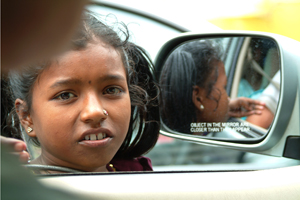 |
|
We are as firm as a rock in the traffic-jam. From the open windows we see a girl flip-flopping and turning between the cars. She dives through a hoop and folds herself in two. When she has done her trick, she pushes her soiled hand into the car. |
| |
| We have had this discussion many times before at home at the kitchen table: whether or not to give to beggars. To give, otherwise how will they survive? Not to give, because otherwise you support the system in which children are even mutilated to increase the chance of income. We have ourselves advised by the autochthonous fellow travellers. They make clear to us that the “untouchables” from the lowest castes ( a system that does not exist anymore officially, but which has hardly changed in appearance) have no other means. Chances of a job are out of the question for this group. |
| |
| My fellow traveller values the performance with 2 rupiahs. The deprived contortionist girl had a higher reward in mind and keeps on talking and looking in a beseeching way. Her little hand is clawing into the direction of “the rest of the money”. |
| |
| I call her to my side. And before she can continue her lament, I tell her that I am much poorer than my neighbour. I am pleading her to return the money and in the meantime I open her little hand. The 2 rupiahs are in her hand and I keep pleading. People around the car start to interfere with the conversation. They laugh and urge her to help me. When she has given me the 2 rupiahs I ask her if she has more and I point at her trouser pocket. She pulls out all the collected money. l look at her languishingly and tell her that I appreciate her generosity very much. She laughs and she stretches out her hand. I take the money. The people around us laugh even louder and say she has done a very good deed. The traffic is moving a bit. I give her back all the money. We shake hands. A motorcyclist next to us strokes her head. She is flip-flopping to the next car. |
| |
| We discuss the basic needs of this child, of all children. Food, clothes, shelter are not enough to survive. Her smile betrayed a lively, playing child that lives inside a hardened, adult mini-body. Humour and fun to put things into perspective told the story of her inside. It showed her resilience. |
| |
| |
| Resilience |
| Large groups of children are living in miserable circumstances. And yet the belief in almost superhuman powers to be able to rescue you from every situation is also of all times. Children in the most desperate situations have risen to give a meaning to their lives from an almost indescribable force. There is a word for this force: resilience. Resilience is the ability to function well and to grow under or after difficult circumstances. Living or working from resilience leads to a different perspective of problems. It is not only about binding up wounds or sticking plasters but it is especially about the trust in the healthy part around the wound. The attention goes out to five elements: |
| 1. The experience of sharing by one or more others: being part of a bigger and safer whole |
| 2. The ability to detect the intention of life |
| 3. Skills with which you have grip on life. |
| 4. A feeling of self-esteem |
| 5. Humour and fun to put things into perspective. |
| |
| And…. A personal place where you store and cherish your dreams, your sorrows and your plans. |
| |
| |
| Relationship and meaning |
| As the basis for resilience we generally find two elements: relationship and meaning. Relationship is in the first place a deep acceptance of the other person. Meaning is often closely related to relationship, but also to a project, a commitment or a (non-sectarian) belief. Resilience is based on the thought that nothing can be obtained definitely, but that nothing can be lost definitely either. That is why resilience can never take the place of a social or economic policy. A suchlike policy can contribute to the advancement of resilience or the destruction of it. |
| |
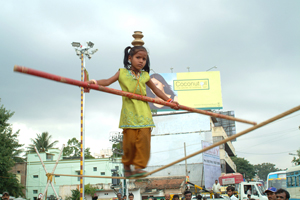 |
|
A day later we are stopping near a girl who is walking the tightrope in the city-centre. Her parents are handing her objects that she puts on her head. She looks concentrated and tense. There is no trace of pleasure or satisfaction to be seen. After her performance she climbs down and she walks towards her public with a small dish. She looks angrily when people give her too little. All photographers must give 100 rupiahs minimally .I give her what she is asking for, but a talk about anything else but “it is not enough” is impossible. She hands the loot over to her parents who react by shaking their heads. Together they are looking at the public in a disapproving way. It was not enough. The girl keeps looking angrily around her. She still is minutes later…… |
| |
| The setting, the circumstances, the training and the mentality have made this girl into a performing circus animal. It is not possible to get through the hard outside layer. Or maybe the inside is equally hard as the outside. Physically she is flexible and strong but emotionally she is stiff and rigid. The term resilience in the sense described above is out of the question. |
| |
| |
| Rights and opportunities |
| Where the circumstances are miserable, special powers are most striking. In 2000 the Norbertine Priest Anthony Sebastion founded ECHO. ECHO (Empowerment of Children and Human Rights Organisation) pays attention to neglected and delinquent youths. ECHO sets itself as goal to secure the rights of children in very difficult circumstances. This vision is carried out and sustained by the law, rehabilitation, education and reintegration into the community. ECHO believes that directed efforts can reform neglected and delinquent youths into responsible citizens. |
| |
| ECHO tries to develop delinquent and neglected youths into free and responsible people in three steps. For that purpose they have appointed three “houses” |
| • Centre for juvenile justice |
| • Transitional home, a “transition” from detention to rehabilitation |
| • Rehabilitation centre |
| |
| |
| Centre for juvenile justice |
| The centre for juvenile justice tries to execute the targets which were put down in the “juvenile justice resolution” in 2000. That resolution describes the rights of children in severe circumstances and the protection they should get. ECHO makes case studies and gives first aid to children in observation homes who are in conflict with the law and in children’s homes to children in need. They give trainings to the “shareholders” of the resolution and undertake actions to transfer children to the transitional homes. They also give trainings to a special juvenile police unit and they are monitoring the juvenile judicial system. |
| |
| |
| Transitional home |
| In the transitional homes of ECHO children get education and special counselling. The activities are focused on change and improvement. |
| |
| The transitional home started on 4 April 2001. The home accommodated 50 boys who were put behind bars for several months by judicature. ECHO believes that a suitable home is indispensable to prepare children for a return to their family and in society. If a child is refused the admittance to his family, it is welcome at the transitional home of ECHO. Since its foundation more than 450 children have visited the home. |
| |
| |
| The counsellors do not know what crimes the children have committed |
| The counsellors do not know what crimes the children have committed. That is not relevant, they think. From the moment they get in, a peaceful continuation is begun. “We simply love them” was the reaction of one of the employees to the question: “How can you counsel these children?” Within a week it cannot be said which children have only been there for just a week or which children have been there for a long time. They do not look back but they look hopefully into the future. |
| |
| The activities in the transitional home of ECHO are aimed at preparing the children for the outside world. ECHO does not believe that children commit crimes consciously. It is the environment, such as a poor, economic background and hard family circumstances, which make them break the law. They make rehabilitation programmes for children who live in conflict with the law or who live a disadvantaged or unprotected life. In order to reform successfully these youths follow a structured daily programme. Each morning starts with music and physical exercises such as walking and yoga to keep the body fit and to get a peaceful mind. The children help in the garden and feed the animals. Some children are not yet able to have good relationships with other people but do find peace and friendship with the animals. Besides they learn to take care of others and they get more self-esteem and a sense of responsibility. After breakfast they get education. |
| |
| |
| “Suddenly we were able to think beyond the mountains” |
| Education is a spearhead and is considered to be one of the most important conditions for a successful future. In the evening the children are helped with their homework. |
| |
| One of the former pupils of the school tells about the importance of education. “We could read and write. Suddenly we could think beyond the mountains. That was fantastic”. |
| |
| Every Sunday the children have to be present at the “Bala Panchayat”, where they discuss their administrative tasks with peers. They evaluate the past week and look ahead to improve their lives. They discuss the desired behaviour. On Sunday night they organise a cultural programme where they can present their talents. ECHO helps the children to set their own targets and to be motivated to realize those. These perspectives help children to feel like a return to society. When the programme has been completed successfully, the children move to the ECHO Rehabilitation Centre. |
| |
| |
| Rehabilitation Centre |
| In ECHO rehabilitation homes youths get professional trainings and they are counselled to participate in working situations. They are prepared to return to their families and in society. One of the ECHO activities is the programme for assistant traffic police. It is led in co-operation with the police department. The programme trains youths who were in conflict with the law. |
| |
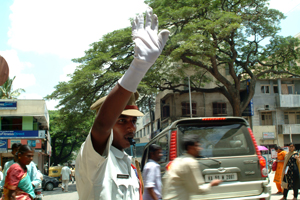 |
|
Munisamy was 19 years old and was trained as an assistant traffic policeman.
“From life on the streets to a traffic regulator was a special journey. I had a very hard childhood. Many of my friends have gone to ECHO. After an intense counselling we could lead normal lives again. It is indeed terrific that buses are stopping when we give a halt signal.”
|
| |
| ECHO creates awareness and stimulates research into juvenile rights at: |
| • Networks of other NGO’s (non-governmental organisations) |
| • The annual organisation of “Bala Mela”, a day for underprivileged children |
| • An awareness campaign for the fate of these youths |
| • Facilitating documentation and research into juvenile rights |
| |
| ECHO Balagrama is the name of the ECHO Rehabilitation Centre in Sumanahalli, Bangalore. Children who have completed the period in the transitional home successfully come to Sumanahalli. The staff at ECHO profoundly discuss together the route the occupant must follow. The children’s interests are always considered and looked upon from the possibilities to improve the quality of life themselves. The youngest ones are encouraged to go to school. For those who are not interested in school professional trainings are provided such as: dressmaker, printer, tanner, carpenter etc. The most successful programme is the ECHO assistant traffic police programme. But also traffic lessons and computer courses are offered as in the transitional home. There children are invited to take part in cultural programmes and to help in the garden. |
| |
| Also here children have to evaluate the week and to set targets for the coming week during the “Bala Panchayat” on Sunday. After the professional training ECHO helps the youngsters find a job. They are also counselled with regard to reintegration into their families. And even when the children live at home again and are at work, they are regularly addressed about the pitfalls of the behaviour that got them into problems once. |
| |
| ECHO Balagrama participates in the National Child Labour Project (NCLP) where it provides basic education for 50 children in dangerous working environments. That teaches the children to protect themselves against the dangers of child labour.The children are stimulated to go to school for a better future. |
| |
 |
|
Shilla and Majana take their sister, a six-month-old baby girl, to school with them. Their father has died. Now their mother can work during the day and they get shelter, food and education. |
| |
| |
| Success factors |
| Stages in which children are counselled from underprivileged situations to situations full of opportunities, are characterised by some success factors: |
| • With a downright humane vision you attract loving and unprejudiced counsellors |
| • Next to physical requirements pedagogical and psychological insights are conditional for a professional counselling |
| • Offences must be considered in a strongly environmentally determined context |
| • Through serious relationships and real involvement a (psychological) insight develops into the resilience (including the ability to develop) of youngsters. That is why it is easier to assess what youths need what help at what moment and if the efforts are useful. |
| • Linkedness is the key not to leave delinquents disconnected. |
| • The focus with regard to the change must be on the perspective. |
| • The whole stage can be fertile if a monitored rehabilitation has been provided for in the network construction, so that youngsters do not fall into “old” behaviour in one of the most difficult phase (the return into the non-counselled situation) |
| |
| And just like in any good educational or relief period youngsters tell the story themselves. Not the beautiful vision, but the ‘stories’ of the youngsters, which are to be heard from their mouths and which are visible in observations accredit the efforts. |
| |
| |
| Aja, Raja en Shalma |
| Aja, Raja en Shalma are three children that stood out in a positive way after their detention. Despite the fact that their families did not care anymore about their fate, they showed insight into their offences and their situation. They also showed conscientious remorse and were languishing for a different perspective. Father Antony took them to ECHO for a hopeful future. |
| |
| |
| Aja |
| Aja was fifteen years old when he presented his PowerPoint presentation. His eyes were shining. “I learned the programme during the past year. I am fascinated by drawing and beautiful pictures. PowerPoint gives me the opportunity to work with these.” He tells in a detailed way about the method and the contents of his presentation about ECHO, where he lives. How did this cheerful child of civil servants end up in this house? His eyes are filled with tears when he tells that both his parents have died. His father died two years ago and his mother last year. He was taken care of by his aunt. “A friend of mine asked me to help him because he had financial problems. I felt obliged to give him some of my parents’ jewels. A relative accused me of theft.” After more than a hundred days in prison he was taken care of by ECHO where he has created a picture of a meaningful future again. “I want to become a software engineer,” Aja says, who is working very hard to pass his school exam. |
| |
| |
| Raja |
| Raja was sixteen when both his parents died. He started living with his sister and brother-in-law. They were very poor. There was no money to be able to send Raja to school. In order to earn money he worked as a carpenter. The money he earned was spent for the major part on booze for his brother-in-law. The family had been terrorized for years by that brother-in-law. One day when his brother-in-law had been drinking again, there was a fight and Raja attacked him and murdered him. The boy was arrested and taken to the observation home. |
| ECHO took him up and counselled him during the whole stage. After his release Raja could not return to his family. He was supervised in the transition home, where he got education. From that period on he could work as a carpenter and so he could earn his own livelihood en he has built up an independent life. |
| |
| |
| Shalma |
| Shalma was a girl of 13. Her parents were very poor and they lived the lives of coolies (wage-slaves). One day Shalma went to her aunt’s house and stole 20 rupiahs (€ 0.35) to be able to buy biscuits. Her family explored the matter and Shalma was afraid of her grandmother’s reaction. She ran away, jumped on the bus and ended up 400 kilometres further down in Bangalore. In the city she was taken from the bus station to a children’s home by the police. There the social workers of ECHO took care of her. They immediately sent a letter to the director of the school in Kadur to report that Shalma was in Bangalore. |
| The director, a teacher and her grandmother arrived at ECHO after a week. Together they went to the children’s home. Grandmother spent 6000 rupiahs, which she had saved for an eye operation, on the search for her granddaughter. Grandmother and Shalma were grateful that they were reunited. Later ECHO received a letter of gratitude from Shalma, her family and the director. |
| |
| |
| New chances quickly |
| One of the warders had seen how I had taught children a song at a school. The children repeated nonsense words while singing. First it was easy, but then it became more and more complex. They danced and laughed very much. The children wanted the same over and over again. When we were in a youth custody centre days later, the warder told the story of 20 children who were sitting on the floor in an open air cager. A boy of 11 had strangled a classmate together with his little brother of 9. A boy of 17 had recently raped his teacher and before he had raped his neighbour’s daughter and his cousin. A boy of 10 had stolen some fruit….. |
| After he had made clear to me the offences he walked to the boys. He told them that I was from the Netherlands and that he had seen how I had taught a song to children at a school. He asked them if they wanted that too. |
| They yelled: “Yes, a song!” |
| With the stories still in my head I started singing and they sang after me. They were dancing and singing and laughing and pulling at each other. I forgot their stories and they also indulged in the fun. After quite some time I said goodbye to them. |
| “Did they all have fun?”, the jailer asked me. |
| “No, not all of them”, I answered, “Almost everybody, but four children could not give themselves up to it. They remained suspicious”. |
| “Exactly! And unfortunately those four children will probably be here for a very long time”, he said, ”and the rest must get new chances very quickly!” |
| |
| |
| A drop in the ocean or not? |
| Do you know how large India is? It is a bottomless pit! Whoever is born in poor circumstances.. All clichés are put forward in a warm house with a glass of wine in one’s hand. Of course many situations are practically hopeless and behaviour sometimes seems unchangeable. But starting lovingly and unbiased from the resilience of youngsters leads to different relationships from those starting from a purely repressive approach. Youngsters do often know very well that repressions were justified. But they were not if they were carried out by counsellors who could not see through the outside. |
| |
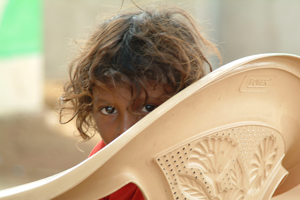 |
|
Oh yes: “A drop in the ocean”, you do hear this very often. But many drops… or rather: |
| |
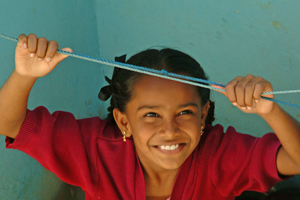 |
|
a child’s future can never be a drop in the ocean!. |
| |
| |







